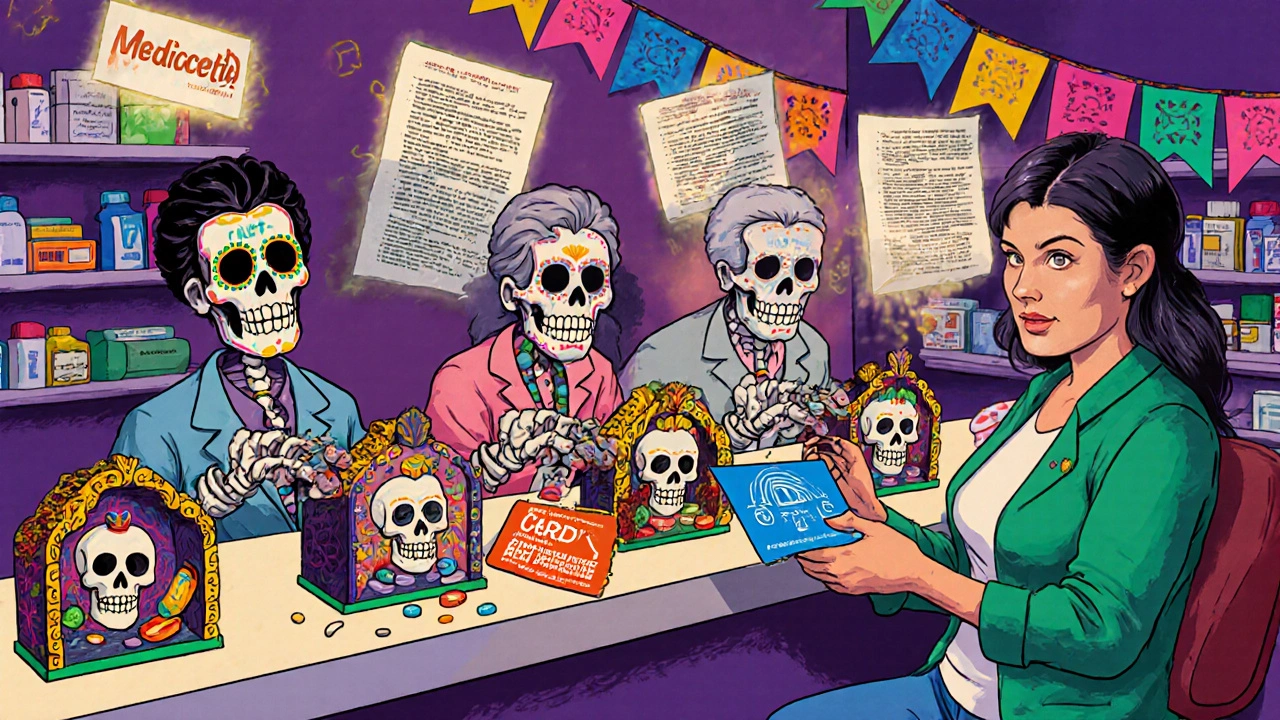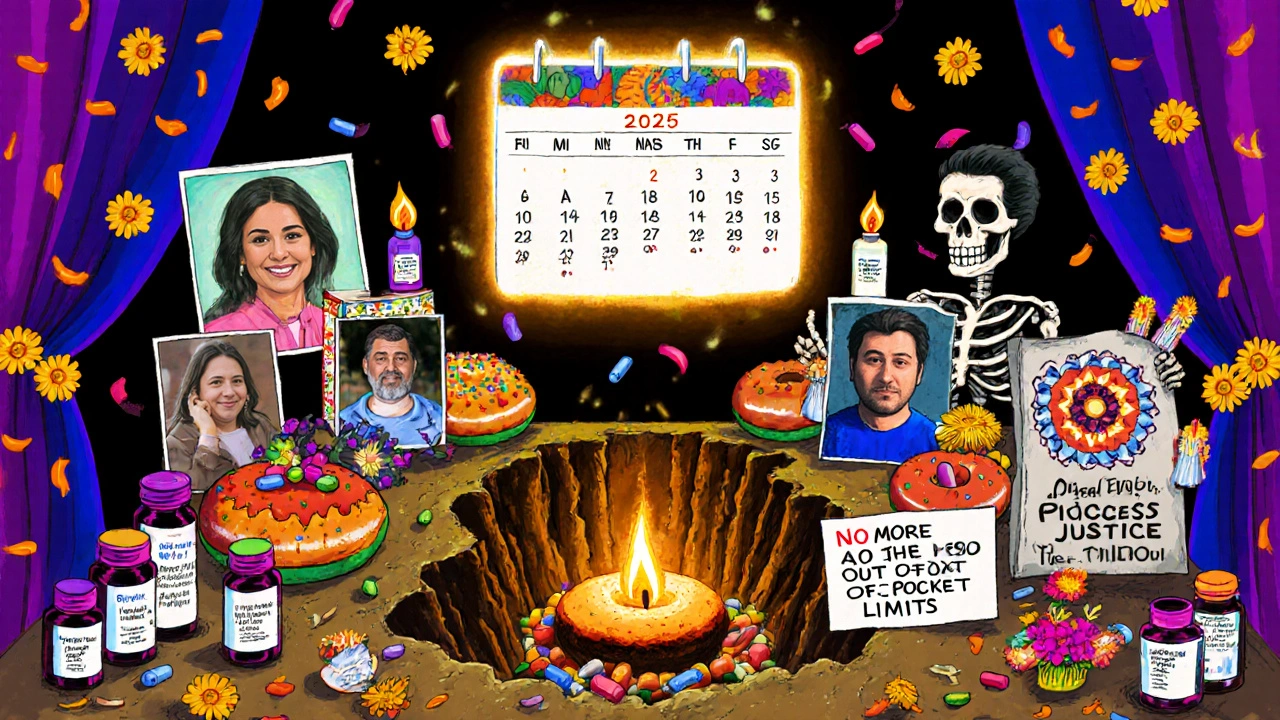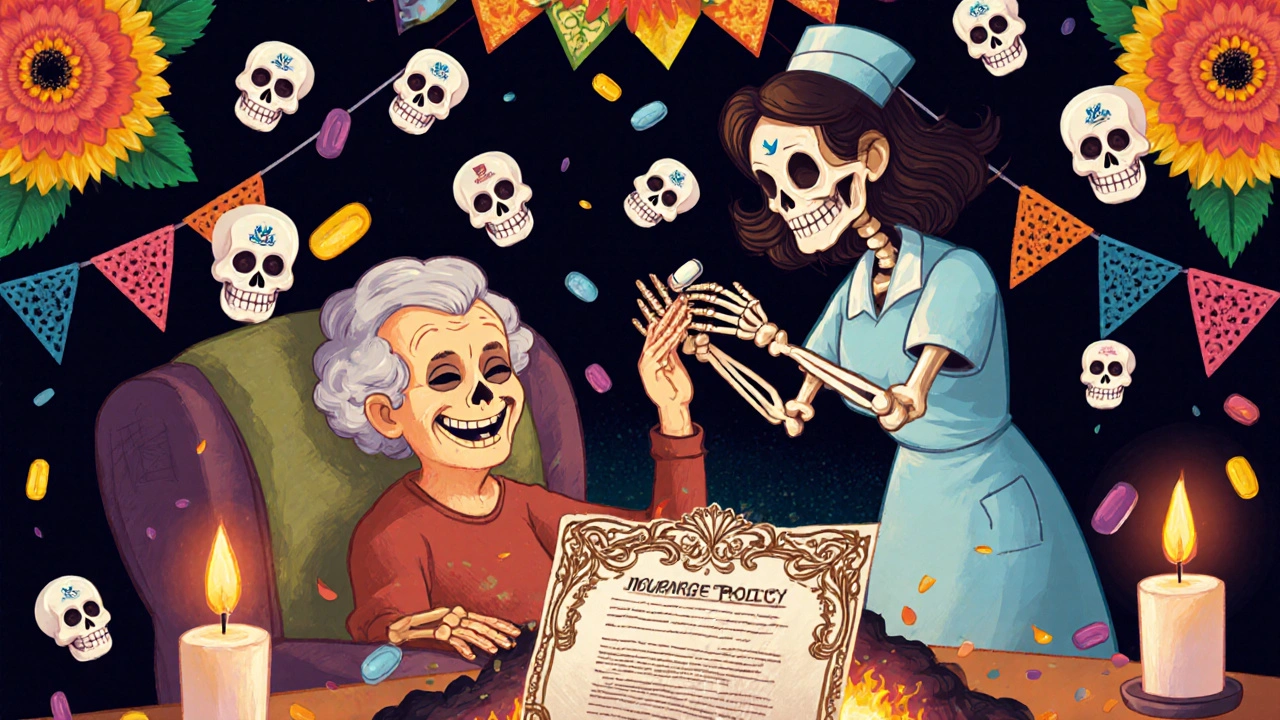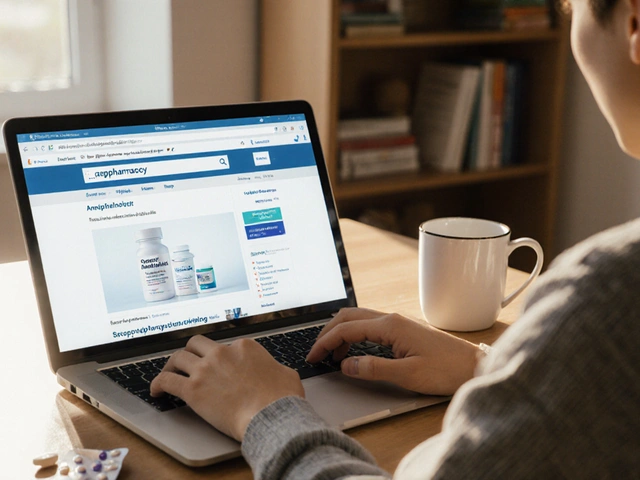Many people assume that if they have long-term care insurance, it will cover everything that happens when they move into a nursing home - including the pills they take every day. But that’s not true. Long-term care insurance does not pay for prescription drugs, not even generic ones. This is one of the most misunderstood aspects of the policy, and it can leave families scrambling when a loved one needs daily medications and has no other coverage.
What Long-Term Care Insurance Actually Covers
Long-term care insurance is designed to pay for help with daily living - things like bathing, dressing, eating, and moving around. It kicks in when someone can no longer do these tasks on their own. The policy covers room and board in a nursing home, assisted living, or at-home care. It pays for aides, therapists, and supervision. But it draws a hard line at medical care. That includes doctor visits, physical therapy, hospital stays, and yes - prescription drugs.
The reason is simple: long-term care insurance was never meant to replace health insurance. It’s meant to fill the gap that Medicare doesn’t cover - the long, slow decline that doesn’t involve acute medical treatment. So if your mom needs insulin, blood pressure pills, or a generic version of a cholesterol medication, that’s not coming from her long-term care policy. It’s coming from somewhere else.
Who Pays for Generic Drugs in Nursing Homes?
For most nursing home residents, the answer is Medicare Part D. Since it launched in 2006, Part D has become the main source of drug coverage in long-term care. By 2020, it was paying for 82.4% of all prescriptions given to Medicare enrollees in nursing homes. That’s more than eight out of every ten pills.
Part D plans cover both brand-name and generic drugs. But they prefer generics - and for good reason. Generics make up about 90% of all prescriptions written in nursing homes, but only cost 25% of what brand-name drugs do. Most Part D plans have lower copays for generics, sometimes as little as $1 to $5 per prescription. That’s why pharmacists and nursing staff push for generics whenever possible.
But here’s the catch: not all Part D plans cover the same drugs. Each plan has its own list - called a formulary - and if a resident’s medication isn’t on it, they might not get it unless someone files an exception request. That process can take days, and in a nursing home where someone needs their meds daily, even a 48-hour delay can be dangerous.
The Medicaid and Dual-Eligible Patchwork
Not everyone in a nursing home is on Medicare. Some rely on Medicaid, especially those with low income. For these residents, Medicaid typically pays for drugs at the actual cost of the medication, plus a small dispensing fee. That means generic drugs are covered without copays.
But here’s where it gets messy: about 60% of nursing home residents are dually eligible - meaning they qualify for both Medicare and Medicaid. For them, Medicare Part D is still the primary payer for drugs, even if Medicaid covers their nursing home room and board. This creates a confusing overlap. The nursing home staff must figure out which plan is active, which pharmacy they use, and which drugs are covered under which formulary.
And it’s not just paperwork. It’s logistics. Each Part D plan works with different pharmacies. If the nursing home’s preferred pharmacy doesn’t have a contract with a resident’s Part D plan, the facility has to switch to another pharmacy - or the resident has to pick up meds elsewhere. Some rural nursing homes struggle to find any pharmacy that works with all the major plans. In fact, 22% of rural facilities report difficulty finding pharmacies that contract with enough Part D plans to serve their residents.

The Hidden Costs of No Coverage
Despite Medicare Part D’s dominance, about 8.9% of long-stay nursing home residents - nearly 30,000 people - have no detectable drug coverage at all. That means they’re paying out of pocket, relying on charity programs, or skipping doses.
These residents often end up in worse health. A 2020 study found that people without drug coverage got far fewer prescriptions than those on Part D. They were more likely to be hospitalized for preventable conditions like uncontrolled diabetes or heart failure. And because they’re already in a nursing home, their decline accelerates.
Even for those with coverage, the system isn’t perfect. Before 2025, Medicare Part D had a coverage gap - the infamous “donut hole” - where beneficiaries paid more after hitting a spending threshold. Though the Inflation Reduction Act of 2022 is phasing out that gap, the changes won’t be fully in effect until 2025. Until then, some residents still face unexpected bills.
How Nursing Homes Manage the Chaos
Nursing homes don’t just hand out pills. They’re now pharmacy management hubs. Staff must track which Part D plan each resident is enrolled in, whether that plan works with their contracted pharmacy, and what drugs are covered. They have to know how to file exceptions for non-formulary drugs. They have to train families on how to appeal denials.
A 2019 survey found that nursing homes spend an average of 10 to 15 hours per week just managing drug coverage issues. That’s over 700 hours a year per facility - time that could be spent on direct care. The cost? About $28,500 annually in staff hours.
The best-run facilities have dedicated pharmacy liaisons and electronic systems that auto-check formularies when a new resident arrives. One 2022 study showed that these facilities cut down the average time to get a new medication from 3.2 days to just 0.7 days. That’s the difference between a resident getting their meds on time - and waiting long enough to get sicker.

What Families Should Do Now
If you’re planning for long-term care - or already in it - here’s what you need to do:
- Confirm whether your loved one is enrolled in Medicare Part D. If not, enroll immediately - late enrollment penalties apply.
- Ask the nursing home: “Which pharmacy do you use, and which Part D plans do they contract with?”
- Get a copy of your loved one’s current drug list and check it against the Part D plan’s formulary. If something’s missing, ask about the exception process.
- Ask if the plan covers all generic versions of their medications. Don’t assume - some plans restrict certain generics.
- Don’t rely on long-term care insurance to pay for drugs. It won’t.
There’s no magic solution. But knowing the system helps you avoid costly mistakes. A simple phone call to the Part D plan’s customer service can prevent a week of missed pills.
What’s Changing in 2025
The Inflation Reduction Act is bringing big changes. Starting in 2025, Medicare Part D beneficiaries will pay no more than $2,000 per year out of pocket for all their prescription drugs - no matter how many they take. That’s a huge win for nursing home residents who often take 10 or more medications daily.
Also, Part D plans will be required to cover all drugs on the official Medicare formulary, and they must approve non-formulary requests for nursing home residents within 72 hours. That should reduce delays and improve access to essential generics.
But experts warn that without stronger oversight, insurers may still find ways to limit access - through step therapy, quantity limits, or narrow pharmacy networks. The fight for affordable, reliable drug coverage isn’t over.
Bottom Line: Insurance Doesn’t Cover Drugs - But Someone Else Does
Long-term care insurance is vital for covering the cost of daily care. But it’s not a health insurance policy. If you think it will pay for your parent’s pills, you’re setting yourself up for a financial shock.
The real answer is Medicare Part D - and for those with low income, Medicaid. Together, they cover nearly 95% of nursing home drug costs. The system is complex, messy, and sometimes slow. But it works - if you know how to use it.
Start with the basics: Know what drugs your loved one needs. Know which plan pays for them. Know how to get them when they’re denied. And don’t wait until a crisis hits to learn the rules. The sooner you understand the system, the better care you can ensure.
Does long-term care insurance cover generic drugs in nursing homes?
No, long-term care insurance does not cover any prescription drugs, including generics. It only pays for non-medical custodial care like help with bathing, dressing, and eating. Drug costs are covered by Medicare Part D, Medicaid, or other health insurance.
Who pays for prescription drugs in nursing homes?
Medicare Part D covers about 82% of prescription drugs in nursing homes. Medicaid covers about 11%, mostly for low-income residents. Veterans Affairs covers a tiny fraction, and about 9% of residents pay out of pocket or get temporary help from charities. Generic drugs are preferred and typically cost less under Part D plans.
What if a nursing home resident’s medication isn’t on the Part D formulary?
The resident or their representative can request an exception. The plan must respond within 72 hours for nursing home residents. If denied, an appeal can be filed. Many facilities have staff who handle this process, but families should stay involved - delays can affect health.
Why are generics so important in nursing homes?
Generics make up 90% of all prescriptions in nursing homes but cost only a quarter of brand-name drugs. They’re just as safe and effective. Part D plans encourage their use by charging lower copays. Switching to generics can save thousands per year and reduce out-of-pocket costs.
What’s changing in 2025 for nursing home drug coverage?
Starting in 2025, Medicare Part D beneficiaries will pay no more than $2,000 per year out of pocket for all prescriptions. Also, Part D plans must cover all drugs on the official Medicare formulary and approve non-formulary requests for nursing home residents within 72 hours. These changes aim to reduce gaps and delays in care.
Can I use long-term care insurance to pay for drugs if I run out of Part D coverage?
No. Long-term care insurance policies explicitly exclude medical care, including prescription drugs. Even if you’ve used up your Part D coverage or hit the out-of-pocket cap, long-term care insurance still won’t pay for medications. You’ll need other options like Medicaid, assistance programs, or direct payment.








8 Comments
Jennifer Shannon November 22, 2025
Wow, this post really opened my eyes-like, I always thought LTC insurance was this magical safety net, you know? But nope, it’s more like a really nice cozy blanket that keeps you warm at night… but doesn’t help when you’re freezing because your heater broke. And generics? Oh my gosh, I had no idea they made up 90% of prescriptions in nursing homes-and cost a quarter of the brand names! It’s wild how much we assume things are covered, and then-bam-you’re stuck paying for insulin out of pocket while your mom’s on a 48-hour meds delay. I’m telling my whole family about this. We’re all getting our ducks in a row before it’s too late.
Suzan Wanjiru November 24, 2025
Part D is the real MVP here. If you’re not enrolled you’re leaving money on the table and risking health. Check formularies. Ask the pharmacy. Don’t wait. Generic is fine. Always go generic unless there’s a medical reason not to. Staff are overwhelmed. Families need to help.
Kezia Katherine Lewis November 25, 2025
The structural inefficiencies in the dual-eligibility landscape are profound. The administrative burden on nursing home pharmacy liaisons is not merely operational-it’s systemic. When Part D formularies are non-interoperable with facility-contracted pharmacies, the result is therapeutic disruption. The 22% rural facility statistic is not an outlier-it’s emblematic of a fragmented care infrastructure. Without standardized formulary alignment protocols, we’re essentially forcing clinical decision-making to be mediated by insurance bureaucracy. The 2025 cap on out-of-pocket costs is a necessary intervention, but without mandatory pharmacy network expansion, access disparities will persist.
Henrik Stacke November 27, 2025
Oh my goodness, I’ve been through this with my mum in Devon-absolute chaos. I mean, we had to switch pharmacies three times because her Part D plan didn’t ‘contract’ with the one the home used. And the delays? She missed her blood pressure meds for two whole days. Two days. She ended up in A&E. I’m not exaggerating when I say this system is a nightmare dressed in paperwork. And yes, generics? Brilliant. But only if they’re actually available. The fact that some rural homes can’t even find a pharmacy that takes more than two plans? That’s not a glitch-that’s a failure. I’m so glad someone finally said it out loud.
Manjistha Roy November 29, 2025
This is such an important conversation that so many families avoid until it's too late. I work with elderly clients in India and while the system here is different, the core issue is the same-people assume insurance covers everything. But medications are medical, not custodial. The distinction matters. Families need to be educated early, not in crisis mode. The 8.9% without coverage? That’s not just a statistic-that’s someone’s mother skipping pills because she can’t afford them. We need more community outreach, more plain-language resources, and more advocacy. Knowledge is power, and right now, too many people are flying blind.
Jennifer Skolney November 30, 2025
PLEASE PLEASE PLEASE if you’re helping a loved one in a nursing home-go to the front desk right now and ask: ‘What pharmacy do you use?’ and ‘Is their drug list covered by Part D?’ I wish someone had told me this six months ago. We almost lost my dad because his cholesterol med wasn’t on the formulary and no one told us until he was dizzy and falling. Now we have a binder with his meds, the plan, the pharmacy, the exception form, and a checklist. It’s a pain-but it saved his life. 💪
JD Mette December 1, 2025
It’s interesting how much of this is invisible until you’re in it. I’ve seen friends struggle with this and never realized how much time and stress goes into just getting a prescription filled. The 10–15 hours per week nursing homes spend on this? That’s time taken away from actual care. I think we need more funding for pharmacy liaisons-not just as a cost, but as a clinical necessity. The system isn’t broken-it’s just not designed for human needs. And that’s a shame.
Javier Rain December 1, 2025
Let me be blunt: if you’re relying on long-term care insurance for drugs, you’re setting yourself up for disaster. Period. The system works-if you know how to use it. But too many people treat this like a ‘set it and forget it’ thing. Nope. You’ve got to be the advocate. Call the plan. Check the formulary. Demand exceptions. Push back. The 2025 cap is great, but it won’t fix lazy administrators or narrow networks. So stop waiting for someone else to fix it. Get on it now. Your parent’s life depends on it.